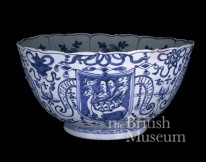1 Ming Export Ceramics

Portuguese merchants pioneered direct trade between Europe and China in the early sixteenth century. Before this, in the Yuan and early Ming dynasties very few porcelains from China were collected in Europe. Dutch and then English traders increased the scale of direct trade in the early seventeenth century. Jingdezhen potters made specially commissioned porcelain. They adapted traditional designs to incorporate foreign motifs such as coats of arms and produced porcelains fashioned on foreign forms. Chinese and Middle Eastern merchants sold some of these European commissions to customers in other areas who found their exotic designs appealing.
Special commissions were a tiny fraction of the overall trade. Some mid-Ming Chinese taste porcelains were purchased in the Middle East and brought back to Europe. Their functions as ordinary cups and bowls changed as elaborate gold and silver mounts were added in Europe, so highly was the material prized. These porcelains appear in religious paintings, royal and aristocratic collections. From later Ming shipwrecks we know that most porcelain cargoes were Chinese taste blue-and-white, celadon and white wares. These bulk trade goods stimulated local copies globally and created a fashion for decorating homes with porcelain.






